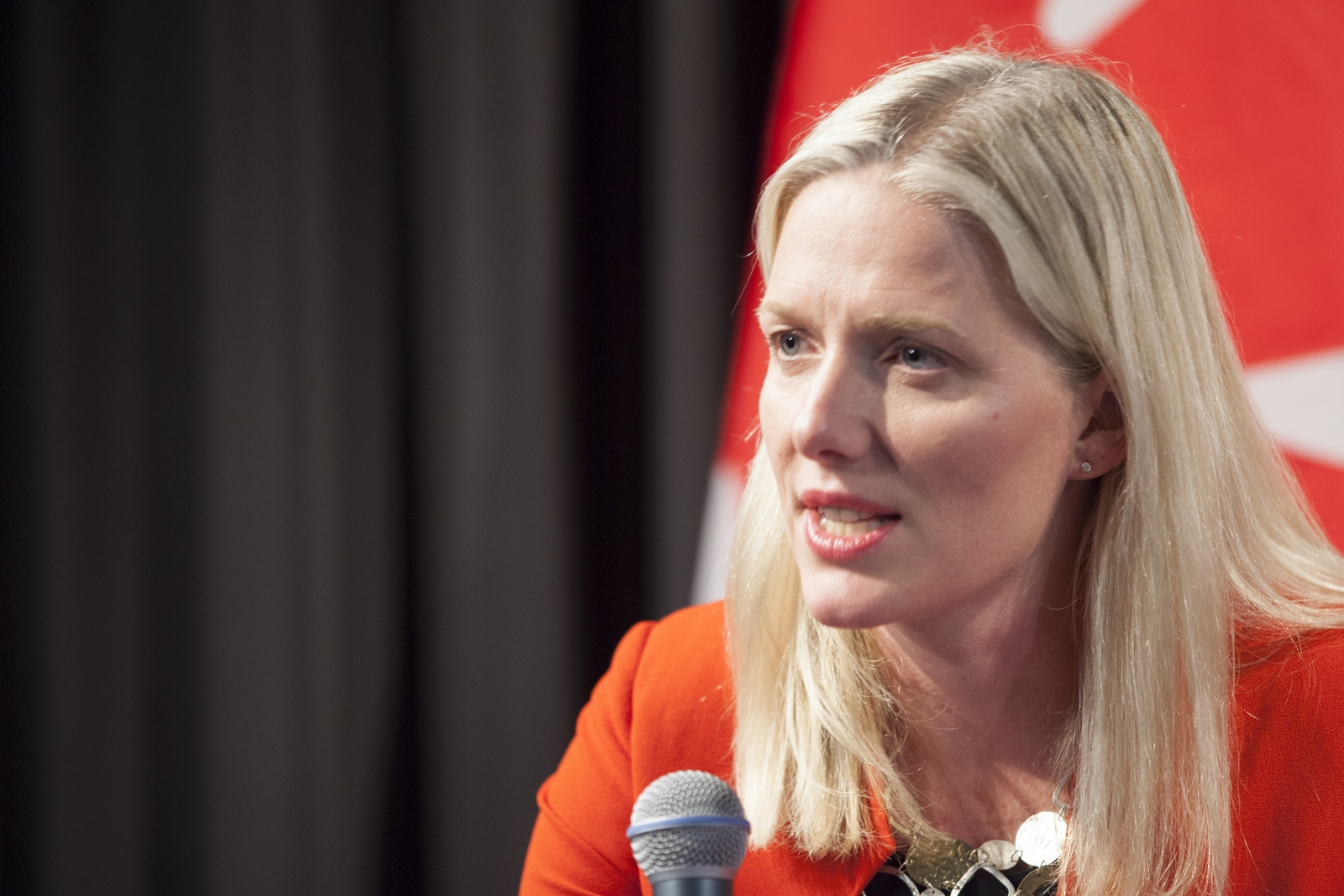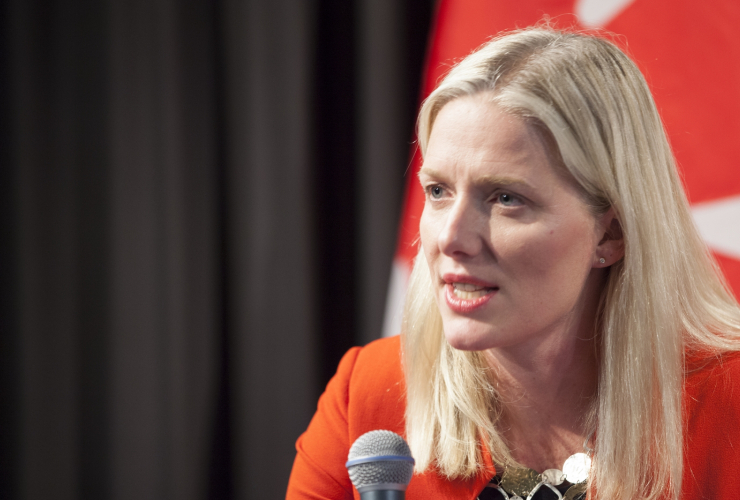It must have been a really slow summer news day.
That was my first reaction last week, when I first read the deeply scandalized reports that Environment and Climate Change Canada had incurred $6,600 in professional photography costs, documenting Minister Catherine McKenna’s attendance at the United Nations climate summit in Paris.
Then when I saw the front page coverage in the Ottawa Sun—the headline “Pork Quoi?” superimposed on a montage with McKenna’s photo—I briefly tried imagining how to manufacture a story, any story, to help reporters get through the late August doldrums.
It just had to be slightly less tenuous than this one. And no more manufactured.
The Globe and Mail got it mostly right, I thought, with an editorial that put a $6,600 expense into perspective.
‘Have We Lost Our Minds?’
“The government is about to spend $1,486,680,000 on buses and subways, and on studies about buses and subways, and the controversy of the day is about an amount of money equivalent to 0.0007 per cent of that massive total?” the paper asked. “Have we lost our minds?”
On one hand, maybe not: The implied logic behind every Access to Information request from any Opposition party that ever targeted ministerial travel is that if you can’t get the small stuff right, you can’t be trusted with the bigger stuff.
But the Globe also pointed to the Canadian (or maybe not only Canadian) instinct toward parsimony over public expenditures that are small enough, yet public enough, to capture our attention. “We don’t want our grandees to become too grand,” the paper noted.
But even as it argued that “we have to stop demanding that our cabinet ministers book the middle seat in economy, or bed down at discount hotels,” the editorial reinforced the consensus that McKenna’s photo budget in Paris was above and beyond.
The minister herself said she would look at how to cut her department’s photography costs in future. Even though $6,600 was a far cry from the staged events where the Harper government would close down whole workplaces, clean them up, and pay workers to stand idle while ministers posed for the cameras. Or last year’s “man in blue suit” episode where the PM and B.C. Premier Christy Clark contrived a victory lap alongside exhausted firefighters during the summer wildfire season.
“They used to regularly hire photographers for everything,” said a senior federal communications executive, speaking on background.
As for McKenna’s photographer in Paris? “That’s a lot of money,” he said, “but you also need to look at what the photos were used for.” Too often in the past, photographers have captured good shots “that ended up in the minister’s office or on a website, and not being used by the department.”
Which points to two important questions that were mostly missed in the mini-storm over a $6,600 contract: Was this particular ministerial excursion worth documenting? And at $6,600, did the photographer deliver value for money?
The Paris Conference mattered
You might be forgiven for judging that the 21st Conference of the Parties (COP21), also known as the United Nations climate summit, was a significant enough event to warrant some onsite photography.
In fact, you wouldn’t be wrong to conclude that it was one of the most important gatherings we’ll see in our lifetimes.
This was the conference where nearly 200 countries reached a global agreement to begin reining in the greenhouse gas emissions that cause climate change. It was the first time virtually every country in the world signed on.
The Paris Agreement is deeply flawed—its carbon reduction targets are voluntary, they’ll have to be toughened up over time, and diplomats spent much of the two-week conference using the UN’s consensus-based process to water down the final deal. But the Paris conference was still a milestone in the global response to the defining challenge of our lifetimes.
And there was good reason for Canada to want a visual record. This was the first opportunity for a newly-elected government to signal a drastically different policy path on climate change—a path the climate and energy community is now working very hard to hold them to. In that sense, this was an arguably weird moment when the more play McKenna’s office received from the photos, the more that government PR reinforced what the community sector is trying to achieve.
Value for money
The other question is whether $6,600 was too high a photography fee for an international conference where McKenna was onsite for seven or eight days, working overtime hours to chair one of the working groups appointed by UN Secretary General Ban Ki-Moon to shepherd the Paris Agreement across the finish line.
I’m not sure whether my past career gives me a window on how to pay photographers, a terminal bias about it, or both. But in the quarter-century or so that my firm specialized in conference publishing, we produced dozens of onsite newsletters that depended on smart, creative photography to help deliver breaking news to hundreds or thousands of delegates.
Over the years, I came to appreciate a quote I first picked up at a retail counter many years ago: “You can pay the going rate for top-quality oats. Or you can get a really good deal after they’ve been through the horse.”
The devaluation of photography, and paying a decent rate
Through that lens (so to speak), $6,600 for photography to document multiple eight- to 12-hour days at the Paris conference struck me as a fantastic deal for Environment and Climate Change Canada, something of a concession on the part of the photographer. And when I asked three of our favourite former freelancers in Ottawa, Vancouver, and Toronto for an update on their rates, I realized just how badly a nickels-and-dimes attitude is driving the decline of professional services that the country’s media—including, ironically, the publications that piled on to this story most eagerly—depend on.
“I was following that ridiculous news coverage on the Paris photography quite closely,” said one of them. “I found the whole story hard to believe,” given standard rates of $125.00 per hour for digital photography, $150 to $250 for processing, and $150 to $300 for copyright.
“If they were hired through a news agency, and the photographers subbed out as contractors, you can add between 25 and 35 per cent to the overall cost.”
“Our industry has fallen out of step so fast regarding pricing guidelines,” said a brilliantly effective freelancer with decades of experience, who hasn’t seen a rate increase since the late 1990s. “Professional photographers are in fear of not getting enough work, so they’ve chosen to decrease their prices overall, 30 per cent less now for government assignments.”
The gap between hours and pay is worst with conferences. “As we know, shooting conferences and conventions requires a huge amount of work, not only being behind the lens, but in front of the laptop downloading, post-processing, sending, ftp’ing a large number of images,” the freelancer noted.
“Eight hours inevitably turns into 10 turns into 12, especially with evening events to document.”
The general consensus: A fee of $1,000 with processing for an eight-hour day, $1,800 for 12, is standard—even in a fiercely competitive market.
The federal communications executive I spoke to had a different solution in mind: simply train ministerial staff to capture images of events when they’re already onsite. “Get a clue about how to use the phone in your pocket, because they take great photos,” he advised.
But the Globe came back indirectly with a powerful answer to that option, extolling the ability of professional photographers to capture enduring, sometimes historic images—like the iconic photo of a Black Lives Matter protester courageously and peacefully standing her ground against armed and armoured law enforcement.
The Globe was arguing for the essential role of independent photojournalists in capturing edgy, controversial stories that no minister’s office of any political stripe would ever publish. (Now, if only papers like the Globe would keep them reliably on staff. At least, unlike the Chicago Tribune, it didn't lay off all its photographers in one fell swoop) But one step down that chain, there are moments when a trained, experienced photographer can cover ground that amateurs can’t. (And I say that as a photographic amateur.)
And one editor I spoke with agreed. "The importance of photography can't be overstated,” she said. “A grainy, dark, red-eye photo on somebody's Blackberry or outdated clamshell phone turns news into an unpublishable, non-shareable story if no one in the room got a good photo."
The debate over McKenna’s photo budget missed the reality that Paris was one of those moments, and the procurement officer who negotiated the contract did a pretty good job of it.
Mitchell Beer is President of Smarter Shift Inc. and curator of The Energy Mix.






Comments